In 2024, building a blockchain application can significantly revolutionize trust and efficiency in various industries. By decentralizing transactions, the technology ensures heightened transparency and security while mitigating fraud risks. Through the seamless facilitation of global transactions and the automation of contracts, blockchain applications streamline processes, enhancing data privacy and supply chain transparency.
Aloa, an expert in software outsourcing, plays a significant role in helping agencies and companies build state-of-the-art software solutions for their businesses. They stand out in connecting businesses with the right blockchain project developers, promising that digital networks adhere to the highest user experience, security, and functionality standards. With a team of highly vetted blockchain developers, Aloa ensures proficiency in using advanced technologies to provide the best results for your blockchain projects.
In this blog, we will go through blockchain applications and their features. We will also tackle the typical uses and benefits of integrating it into your platforms. Afterward, you’ll learn how to build blockchain projects with its essential user and admin side features, ensuring a secure, efficient, and transparent application for your networks.
Let’s dive in!
What is a Blockchain Application?
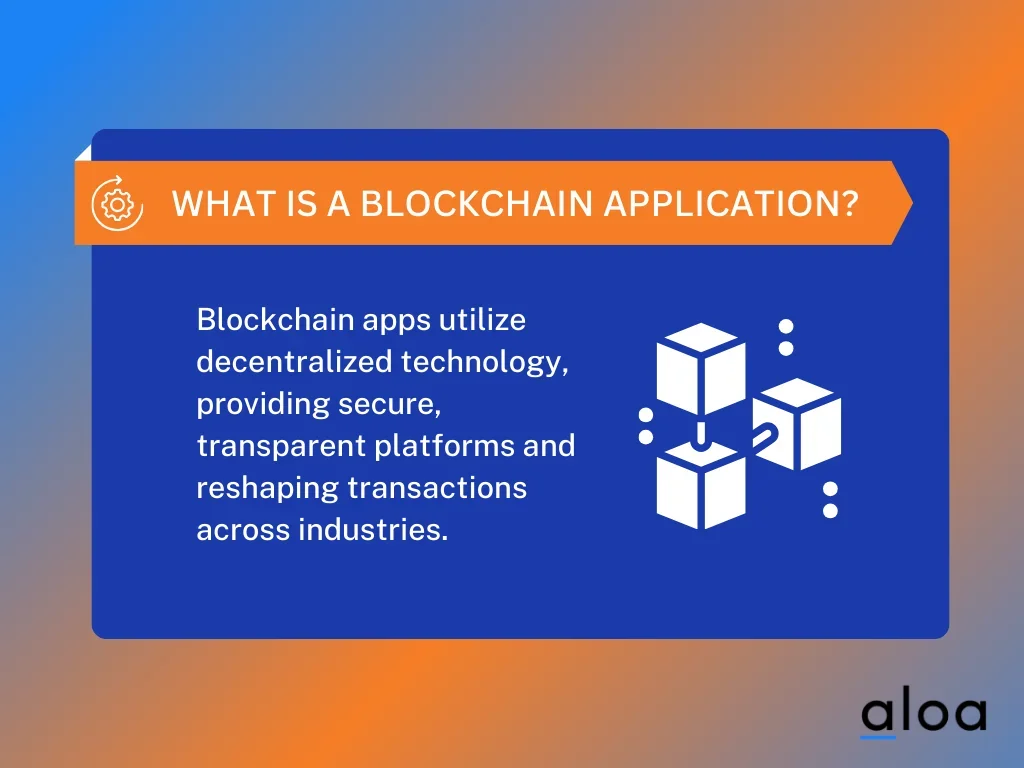
A blockchain application is a decentralized application built on blockchain technology. This innovative approach relies on a distributed ledger shared among computer nodes, creating a secure, transparent, and censorship-resistant platform for network participants. The fundamental strength of blockchain projects lies in their ability to store data and execute transactions with unparalleled security and transparency.
By utilizing a distributed ledger, these applications ensure that once data is recorded, it becomes immutable, fostering a verifiable and auditable history of transactions without the need for a centralized entity. The versatility of blockchain projects extends beyond cryptocurrencies like Bitcoin and Ethereum. They find applications in various industries pivotal in digital identity verification and supply chain management.
Since the inception of Bitcoin in 2009, the impact of blockchain technology has evolved significantly. The explosion of various cryptocurrencies, the rise of decentralized finance (DeFi) applications, the advent of non-fungible tokens (NFTs), and the implementation of intelligent contracts showcase blockchain applications' expansive and transformative potential.
The decentralized nature, coupled with the immutability and transparency of the blockchain, positions these applications as resilient and reliable solutions across diverse industries, fundamentally reshaping how transactions and data are efficiently handled today. By integrating a reliable RPC node provider, blockchain applications can further enhance their performance and scalability, ensuring efficient data processing and transaction handling.
How to Build a Blockchain Application 2024
Developing a successful blockchain application in 2024 necessitates combining a strategic approach, user-friendly design, sophisticated features, and stringent security protocols, resulting in a successful blockchain that meets the demands of both technology and user expectations. Here's a glimpse into the essential development steps for creating a blockchain project:

Step 1: Analyze the Industry for Blockchain App Development
Looking at industries like finance, insurance, healthcare, real estate, retail, supply chain, and gaming is the initial step in building a blockchain application. The goal is to figure out what each industry needs and how blockchain could be helpful for them. Learn from examples like JP Morgan Chase and Insurwave to see how others have successfully used blockchain to make things clearer, faster, and more secure in their businesses.
Here are some steps you could consider in analyzing the industry:
- Dive into Sectors: Thoroughly explore various industries to identify specific areas where blockchain can bring transformative value to app development.
- Tailored Blockchain Solutions: Innovate by understanding unique industry needs and tailoring blockchain solutions to address those needs effectively.
- Insights from Pioneers: Learn valuable insights from industry leaders such as JP Morgan Chase and Insurwave, understanding the nuances of successful blockchain implementations.
- Revolutionizing Finance: Examine how blockchain can revolutionize finance, bringing transparency and efficiency to financial transactions.
- Building Retail Trust: Implement blockchain strategies inspired by successful implementations at Overstock and Expedia to enhance trust in retail transactions.
Step 2: Finalize an Idea for your Application
Deciding on the unique concept of your blockchain project is crucial at this stage. It is where you shape the blueprint of your application and determine its development stage. This involves developing a creative and innovative idea while considering whether blockchain is necessary for your project. It's a critical step where you balance the potential for profitability with the development costs. The goal is to establish a clear direction for your blockchain application that meets specific needs and adds value using a consensus mechanism such as proof of work.
Below are crucial steps to consider when finalizing your concept.
- Crafting a Unique Blueprint: Formulate a distinctive and innovative idea, preparing a detailed blueprint for the blockchain projects.
- Necessity Assessment: Rigorously assess the necessity of blockchain in your application concept, ensuring a well-founded approach.
- Balancing Profitability: Balancing profitability and development costs, considering trade-offs and potential revenue streams.
- Enhancing Transparency: Explore scenarios where blockchain can enhance transparency, improving your application concept.
- Validation through Testing: Test and validate the necessity of blockchain for your application, ensuring a robust foundation for development.
Step 3: Do Competitor Research
This step involves carefully studying other players in the field of blockchain application development. It's about understanding their strategies, where they excel, and where they might face challenges. Learning from competitors through platforms like LinkedIn or Facebook can give you valuable insights to shape your approach to blockchain projects. Not only can you stay innovative, but you can also adapt to market trends and position yourself strategically on the competitive edge of blockchain project development.
Let’s explore a few essential factors when doing competitor research:
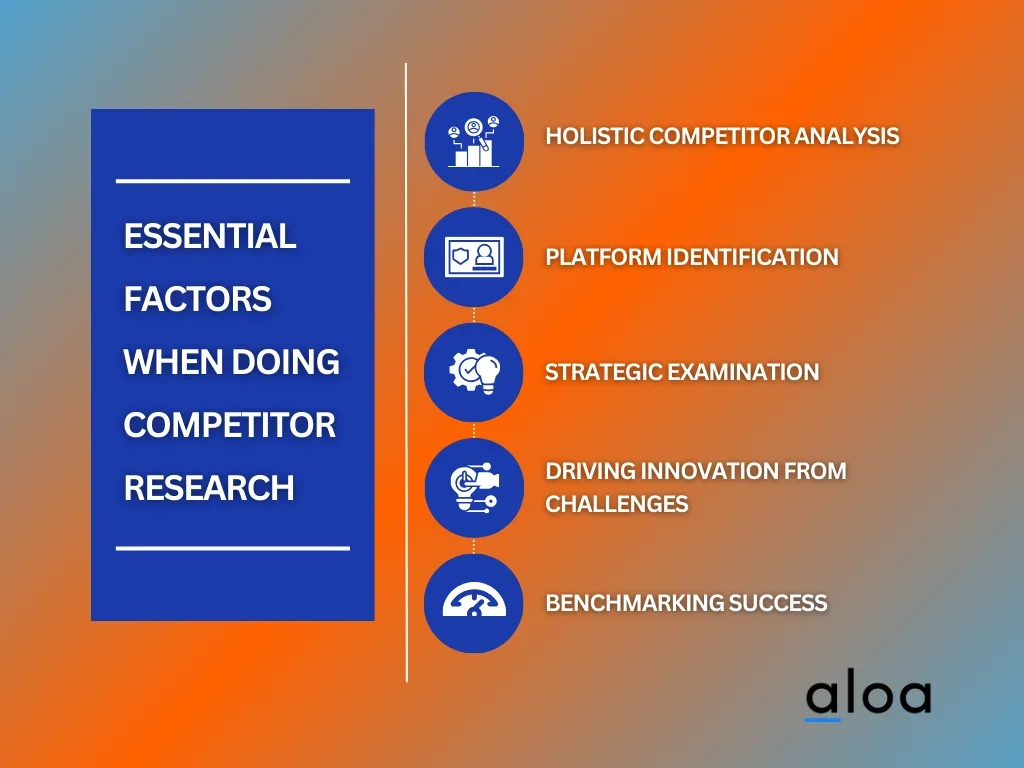
- Holistic Competitor Analysis: Conduct a comprehensive analysis of competitors, understanding their strategies, strengths, and weaknesses.
- Platform Identification: Identify competitors through platforms like LinkedIn or Facebook, gaining insights into their presence in the blockchain app development space.
- Strategic Examination: Strategically examine competitors' innovations in blockchain technology, identifying areas for differentiation and improvement.
- Driving Innovation from Challenges: Understand how competitors approach and overcome challenges, leveraging these insights for innovative solutions.
- Benchmarking Success: Benchmark against competitors to refine your strategies and ensure success in the dynamic blockchain landscape.
Step 4: Choose a Platform for Your Blockchain Project
Picking the platform for your blockchain project involves choosing between creating a new system from scratch or using existing ones like Ethereum or Hyperledger, which act as operating systems for blockchain app development. The platform you choose will impact how smoothly your project runs, from development to how it handles tasks. It's about finding the best fit for your project's goals and technical needs and laying the groundwork for a successful blockchain application.
Here are some steps to consider when choosing a platform:
- Informed Platform Selection: Make intelligent and informed choices in selecting a platform based on meticulous market research and analysis.
- The decision between Crafting and Adopting: Decide between crafting a new framework or adopting existing platforms like Ethereum, Hyperledger, R3 Corda, or Ripple.
- Tailoring to Specific Needs: Tailor your platform choice to suit your project's specific needs and requirements, ensuring optimal compatibility.
- Harmony in Programming: Evaluate programming languages and choose a platform that harmonizes with your development team's skills and preferences.
- Aligning with Tech Goals: Ensure your platform aligns seamlessly with your blockchain project's technical goals and requirements.
Step 5: Design Your Blockchain Application
Designing a blockchain app involves creating a well-thought-out, easy-to-use platform that meets users' needs while considering the latest trends and developments in the blockchain market. Once done choosing a platform, implement the blueprint for the blockchain app. Using up to 20% of your budget, this phase is crucial to ensure the app works seamlessly. Figure out how everything fits together, focusing on making it easy for users. Prioritizing their experience, smooth navigation and accessibility ensure your app is visually appealing and user-friendly.
Let’s dive into factors to consider when building your blockchain app.
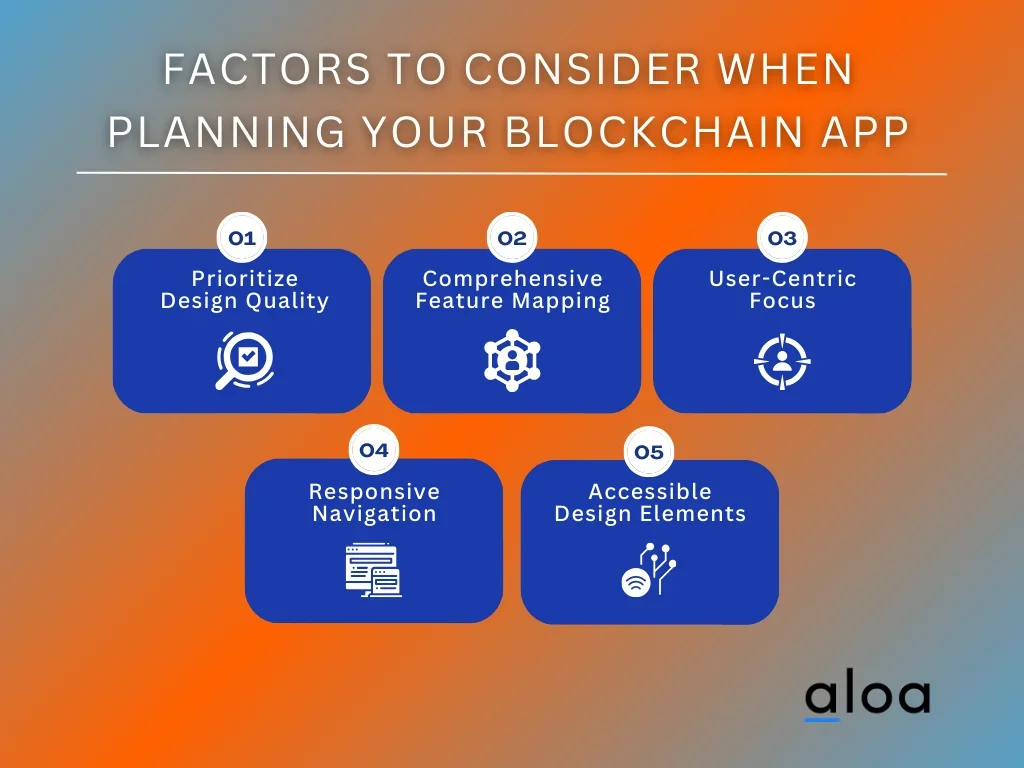
- Budgeting for Design Excellence: Allocate a budget that allows for excellence in the design phase, recognizing its critical role in the application's overall success.
- Comprehensive Feature Mapping: Map out features comprehensively, ensuring a cohesive and functional design that aligns with user expectations.
- User-Centric Focus: Prioritize a user-centric design that enhances the blockchain platform's overall user experience (UX).
- Seamless Responsive Navigation: Ensure seamless navigation with a responsive design, catering to users across various devices and screen sizes.
- Accessible Design Elements: Craft visually appealing and accessible designs, following accessibility guidelines to cater to a diverse user base.
Step 6: Start the Development and Testing Process
This step is where the plans become reality, and the actual coding begins. The key is to make intelligent decisions about programming languages and methods, ensuring a smooth transition from ideas to existing code. Testing is crucial to confirm that everything works as intended, including the business logic and blockchain integration. And, of course, meeting app store requirements is essential for a successful launch. This step marks the phase where your envisioned blockchain application takes shape, becoming a real, functional, and user-friendly solution.
Here are some key factors to consider when creating the development and testing process:
- Precise Development Kickoff: Initiate the development process precisely, considering factors such as programming languages and consensus methods.
- Straightforward Development Approach: Choose between existing blockchains, Blockchain as a Service (BaaS), or crafting your blockchain with a clear understanding of the development approach.
- Ensuring Smooth Transition: Assure a smooth transition by clarifying details before the coding starts, setting the stage for a seamless development process.
- Confident Testing Procedures: Conduct thorough testing, instilling confidence in the functionality and reliability of your blockchain application.
- Ensuring Compliance for Success: Comply with app store requirements, ensuring your blockchain meets all standards for a successful deployment.
Step 7: Maintenance and Support
Ensure the well-being and assistance feature of your project. This step is about regularly checking and updating to keep things running well. Maintenance keeps everything smooth by adding new stuff and making adjustments. Support means being there to assist users with any issues, making sure their experience goes smoothly. This step is crucial for your blockchain app's long-term success, ensuring it stays reliable, secure, and works well.
Below are some factors to consider when doing this step.
- Implementing a Sustainable Support System: Establish a robust maintenance and support system that ensures the continuous success of your blockchain application.
- Evolving with Regular Updates: Evolve with regular updates, incorporating new features and adjustments to align with evolving business requirements and user expectations.
- Partnership for Expertise: Partner with professional application maintenance services, tapping into their expertise to enhance and optimize your blockchain project.
- Prioritizing Security Assurance: Prioritize security through regular security audits and assessments, addressing potential vulnerabilities and ensuring user data protection.
- Building Customer Trust: Assure your customers with a secure, streamlined maintenance process, emphasizing their continued trust in your blockchain application.
Features of a Blockchain Application
Exploring a blockchain project reveals crucial elements for both project administrators and users. These features are vital for creating a smooth and effective implementation of the blockchain solution.
Let's look at the key aspects from both the admin and user sides, ensuring the success of your blockchain project and providing a user-friendly and secure experience.
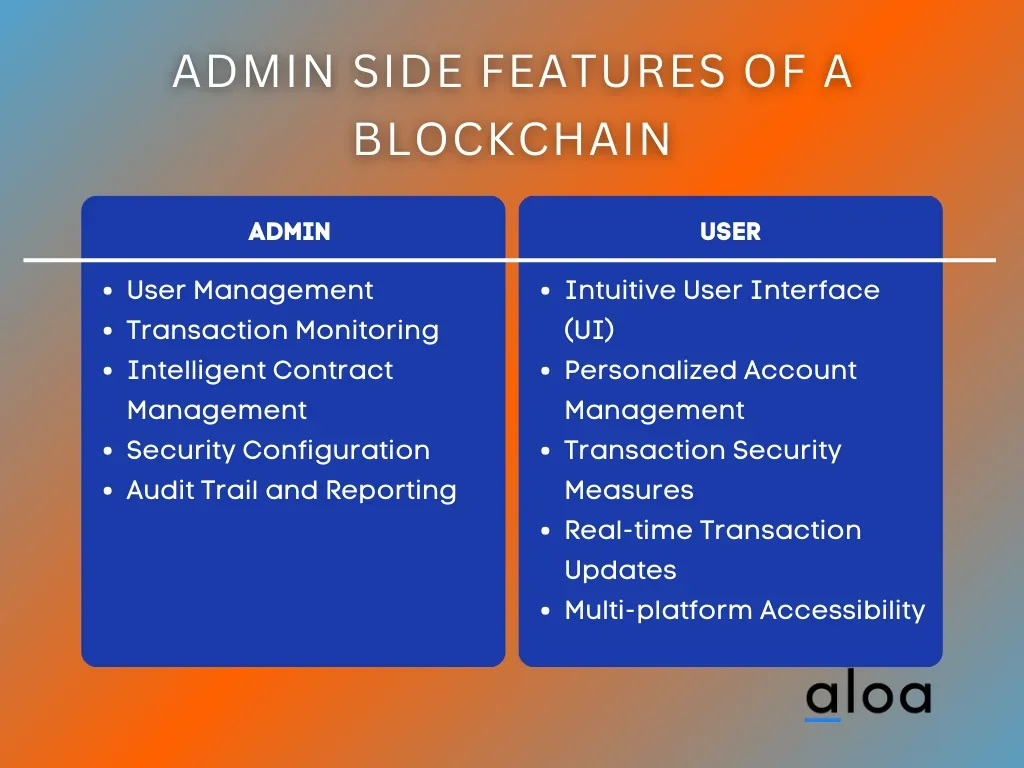
Admin Side Features of a Blockchain
Admin side features of a Blockchain Application incorporate various tools and capabilities designed for administrators to manage and control the application efficiently. These features allow administrators to navigate and control the application, ensuring smooth operations, informed decision-making, and optimal security performance.
Some essential admin side features are as follows:
- User Management: Efficient tools for administrators to manage user roles, permissions, and access levels within the blockchain project, ensuring proper security and compliance.
- Transaction Monitoring: Real-time monitoring and tracking of transactions, providing administrators with insights into the flow of data and assets, helping identify any irregularities or potential issues.
- Intelligent Contract Management: A user-friendly interface for administrators to deploy, update, and manage smart contracts on the blockchain, ensuring seamless execution of predefined agreements.
- Security Configuration: Robust security features and configurations allow administrators to set encryption protocols, implement multi-factor authentication, and establish secure communication channels to safeguard sensitive data.
- Audit Trail and Reporting: Comprehensive logging and reporting capabilities, enabling administrators to generate audit trails and reports for regulatory compliance, troubleshooting, and performance analysis.
User Side Features of a Blockchain Application
The user-side features of a blockchain project yield transaction security and transparency. These features give users peace of mind when making monetary activities on your platform. Consider these essential user-side features of a blockchain project for a more efficient and secure user experience:
- Intuitive User Interface (UI): Craft a user-friendly interface that simplifies navigation, avoids unnecessary complexities, and ensures a smooth user experience with the blockchain application.
- Personalized Account Management: Implement features that allow users to customize and manage their accounts according to their preferences, providing a personalized experience and enhancing user engagement.
- Transaction Security Measures: Prioritize the implementation of robust security protocols to safeguard user transactions. Utilize encryption and authentication mechanisms to ensure the confidentiality and integrity of user data during transactions.
- Real-time Transaction Updates: Provide users real-time updates on their transactions, offering transparency and immediate feedback. This feature enhances user confidence and trust in the blockchain project.
- Multi-platform Accessibility: Ensure the blockchain is accessible across various devices and platforms, enabling users to seamlessly interact with the blockchain network from desktops, laptops, tablets, and mobile devices for convenience and flexibility.
Benefits of Implementing Blockchain in Your App
Creating a blockchain for business can offer a wide range of benefits that positively impact various operations within the company and improve customer interactions. Blockchain developers can utilize these features when they create a blockchain application, focusing solely on security and efficiency.
Here are some key benefits that businesses often realize when they create and implement blockchain:
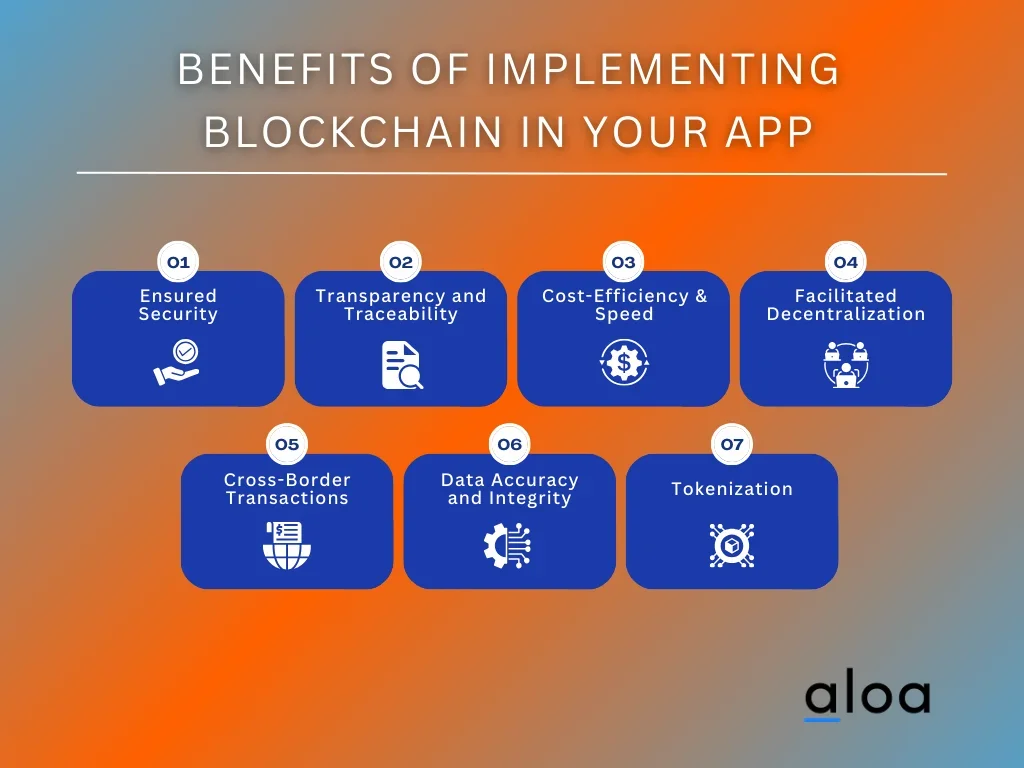
Ensured Security
Implementing blockchain in your app heightens security by using a private blockchain and establishing a decentralized system. This approach ensures secure and tamper-proof data, creating a safe transaction space. Blockchain applications protect against unauthorized access, using smart contract codes to automate transactions and enhance security for all network members.
Transparency and Traceability
Implementing blockchain applications brings transparency and traceability, allowing users to track transaction history easily. Through smart contracts and automated intelligence, blockchain development provides transparent and auditable business processes with real-time transaction traceability. This transparency is crucial for businesses aiming to build consumer confidence, streamline operations, and gain a competitive edge by leveraging a secure and transparent environment for data storage.
Highlighted Cost-Efficiency and Speed
Integrating blockchain applications brings cost-efficiency and speed improvements. Optimizing software development through a decentralized system and improved user interface development streamlines business processes, reducing reliance on third parties. Additionally, leveraging intelligent contract automation further reduces operational costs while improving transaction speed and process efficiency for participants in the blockchain network.
Facilitated Decentralization
Blockchain applications introduce decentralization, eliminating the need for a central authority. This democratized approach ensures that no single entity controls the entire network, reducing the risk of manipulation or fraud. It empowers users and enhances trust by distributing authority across the network, fostering a more inclusive and resilient ecosystem.
Enabling Seamless Cross-Border Transactions
Blockchain's decentralized nature facilitates seamless cross-border transactions, eliminating the need for intermediaries and reducing transaction costs. This benefit is precious for businesses engaged in international trade, as it ensures faster and more cost-effective transactions, enhancing overall financial efficiency.
Data Accuracy and Integrity
Blockchain's distributed ledger system ensures accurate and reliable record-keeping, minimizing the risk of data errors or discrepancies. The immutability of the ledger guarantees the integrity of data over time, providing a trustworthy source of information. This is especially beneficial in industries where precision and accuracy are paramount, such as healthcare and finance.
Tokenization
Blockchain applications enable tokenization, representing real-world assets digitally. This opens avenues for innovative financial instruments, such as tokenized securities and digital assets, providing new investment opportunities. The tokenization of assets enhances liquidity and accessibility, contributing to a more dynamic and innovative financial landscape.
Blockchain Application: Common Use Cases Today
Having a blockchain application today means unlocking a world of enhanced security, transparency, and efficiency across different industries. From revolutionizing financial transactions to optimizing supply chain management, blockchain shapes our daily experiences.
Here are some of the common use cases of blockchain technology today:
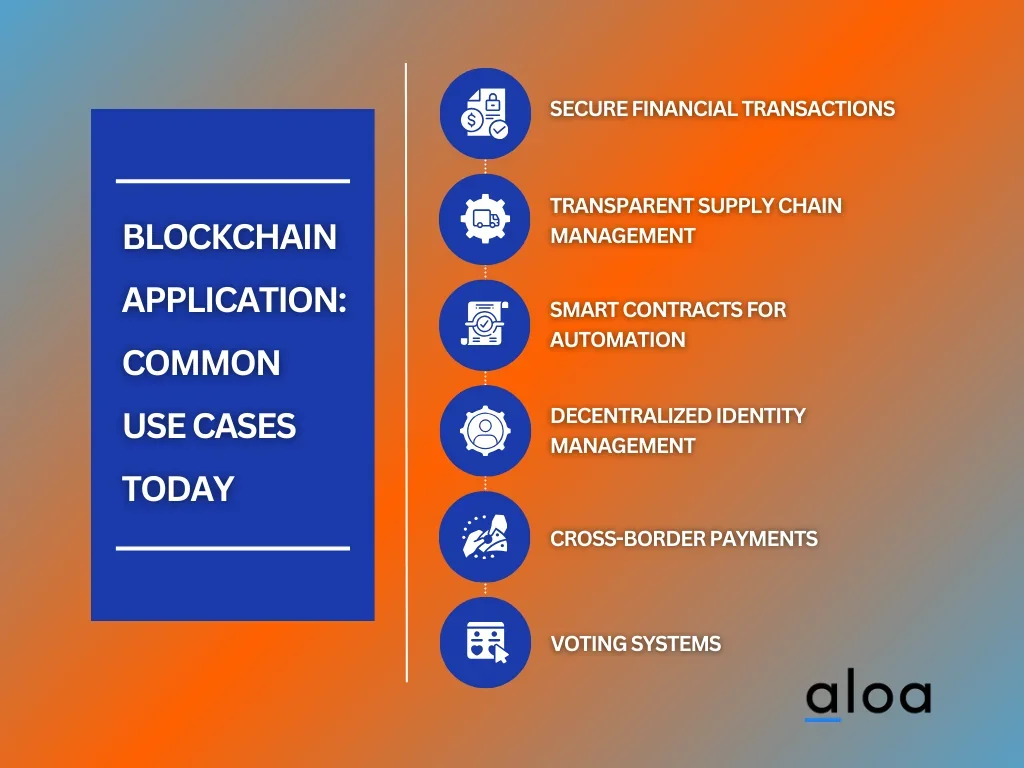
Secure Financial Transactions
In financial transactions, blockchain ensures strong security and transparency. By using advanced cryptographic techniques and a decentralized ledger, it reduces the risk of fraud and builds trust in digital payments. This makes blockchain applications stand out as a key player in reshaping how we handle money transactions, providing a robust foundation that supports various financial activities.
Transparent Supply Chain Management
Blockchain transforms supply chain management by making it more transparent. Using a secure and unchangeable ledger, it records product updates and progress, helping stakeholders trace and verify its flow. This transparency is essential in industries like food and pharmaceuticals, ensuring trust by tracking product origin, quality, and distribution. Blockchain also encourages collaboration and trust among supply chain participants, providing a shared and secure record for collective monitoring.
Smart Contracts for Automation
Smart contracts on blockchain represent a game-changing development in automation. They are self-executing agreements coded directly into the blockchain, streamlining processes across industries. Unlike traditional contracts, smart contracts don't need intermediaries like banks, reducing costs and boosting efficiency.
The secure and transparent nature of blockchain ensures tamper-proof records of contract outcomes. As smart contracts become more widespread, they bring automation to supply chain management, financial transactions, and other financial activities, fundamentally altering how businesses handle agreements.
Decentralized Identity Management
Decentralized identity management, made possible by blockchain, transforms how we handle sensitive digital information. This technology uses cryptography to make digital identities tamper-proof, providing a secure and decentralized platform for individuals to safeguard their data privacy against identity theft and large-scale cyber threats.
Cross-Border Payments
In cross-border payments, blockchain applications simplify transactions by cutting out intermediaries and using decentralized technology. This speeds up the process and reduces global trade and finance business costs. With blockchain, transactions happen directly between parties, making payments faster and more efficient. Blockchain enhances inclusivity in emerging markets, providing a streamlined, cost-effective, and secure solution to global trade and cross-border payments.
Voting Systems
Blockchain applications transform voting systems by ensuring security and transparency. Its decentralized structure makes the voting process resistant to tampering, reducing fraud risks. Every aspect, from voter registration to result tallying, is securely recorded in an unchangeable ledger. This boosts the accuracy of elections and allows voters to verify their votes, fostering confidence in the process independently. Beyond fortifying electoral integrity, the technology reshapes democratic processes, promoting transparency and cybersecurity while instilling confidence in democratic principles worldwide.
Key Takeaway
Building an efficient blockchain application ensures secured and transparent transactions. However, the demand for blockchain projects requires a secure, user-centric, and advanced technology solution. Utilizing all essential features, factors, and steps in building a Blockchain project will save you valuable resources like money, time, and effort while guaranteeing optimal security for your target audience.
While building your blockchain application poses many benefits, doing so may be challenging. But with the right development team and experts, you can turn these challenges into opportunities. From conceptualization to implementation, their expertise ensures a seamless process. Ready to build your blockchain application?
Connect with Aloa at [email protected] today. Our competent team is committed to linking you with skilled experts specializing in blockchain project development. Their experience will turn your concepts into reality, ensuring a tailored, secured, and successful blockchain project in 2024. Sign up for our email list through our blog page to stay updated on the latest insights and trends regarding blockchain technology.

